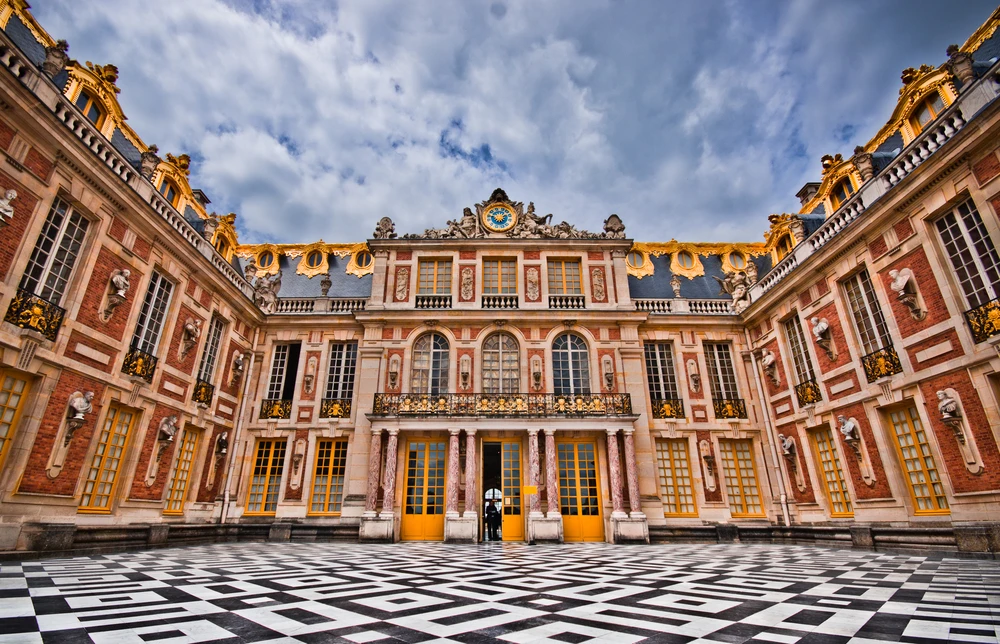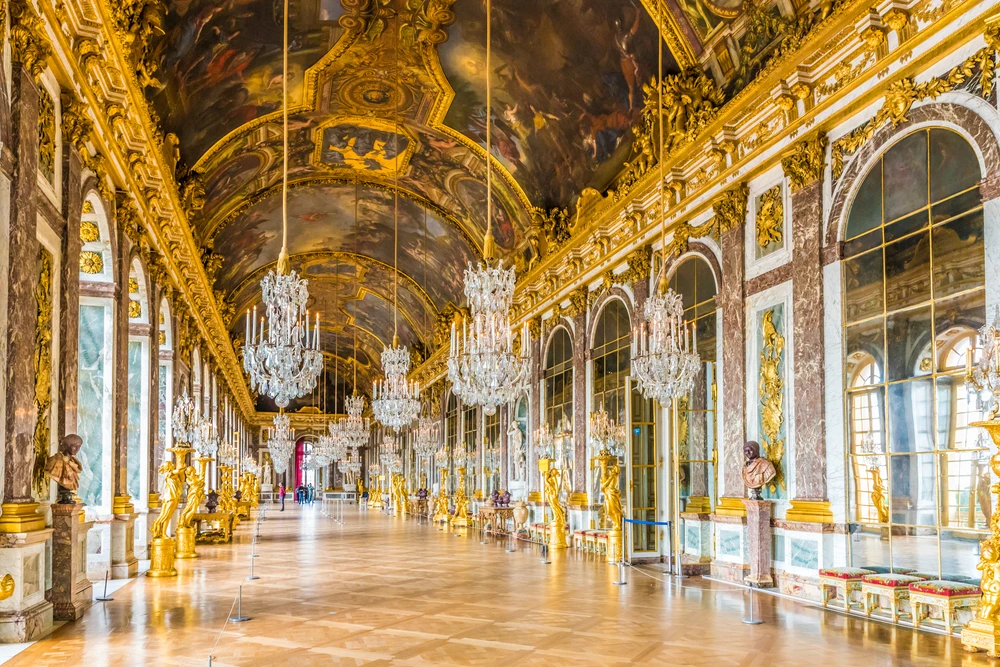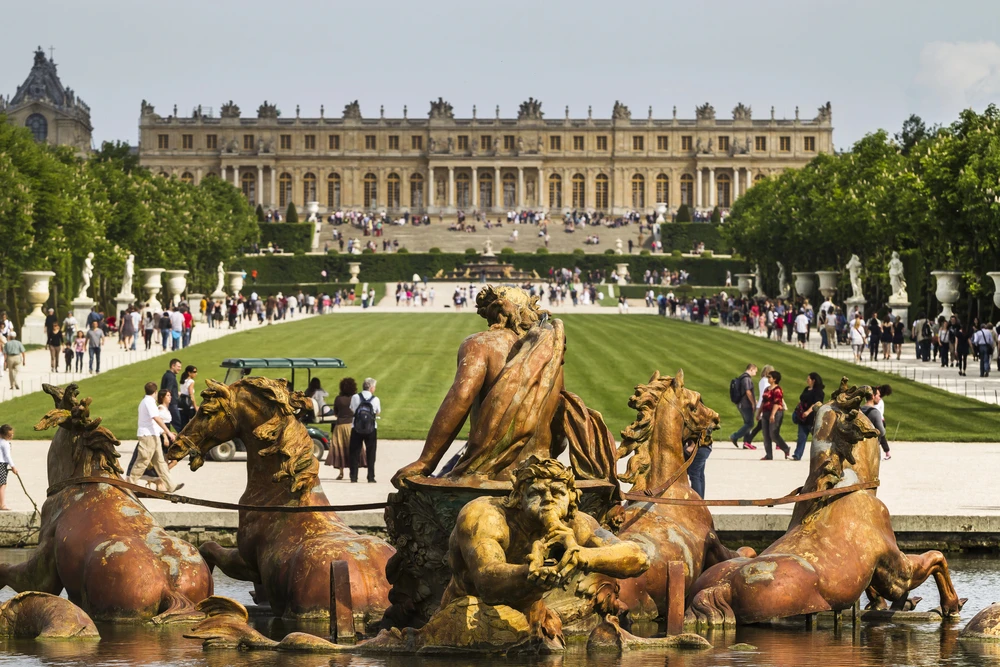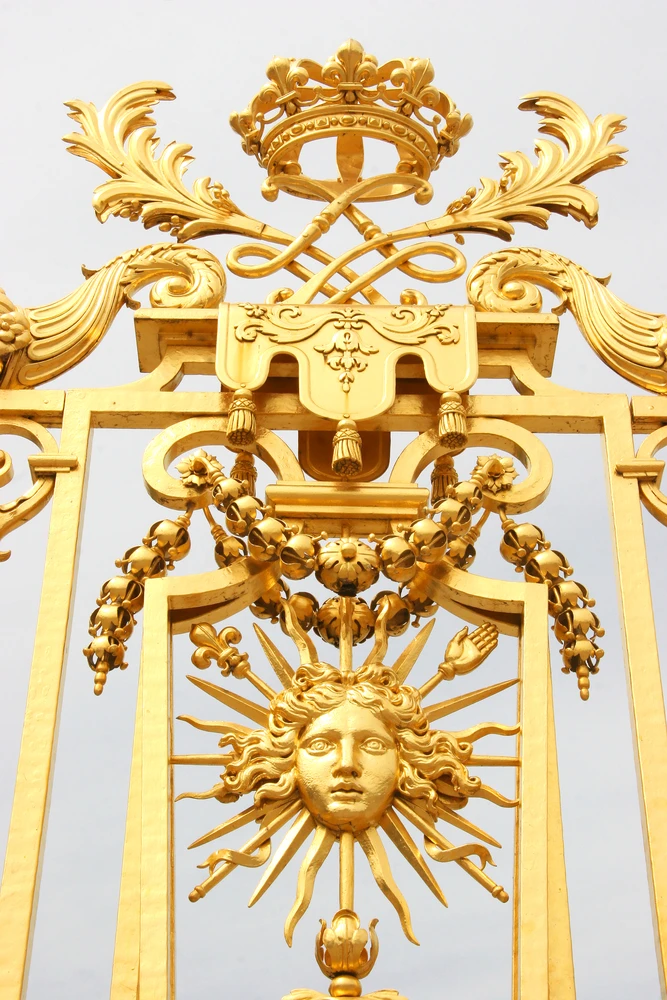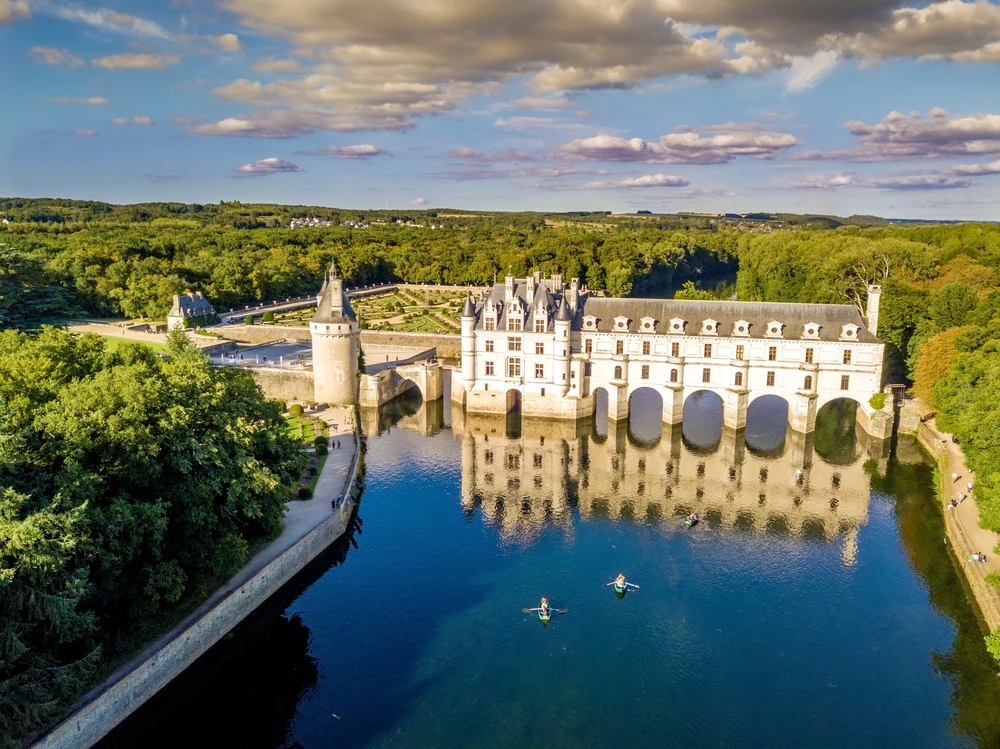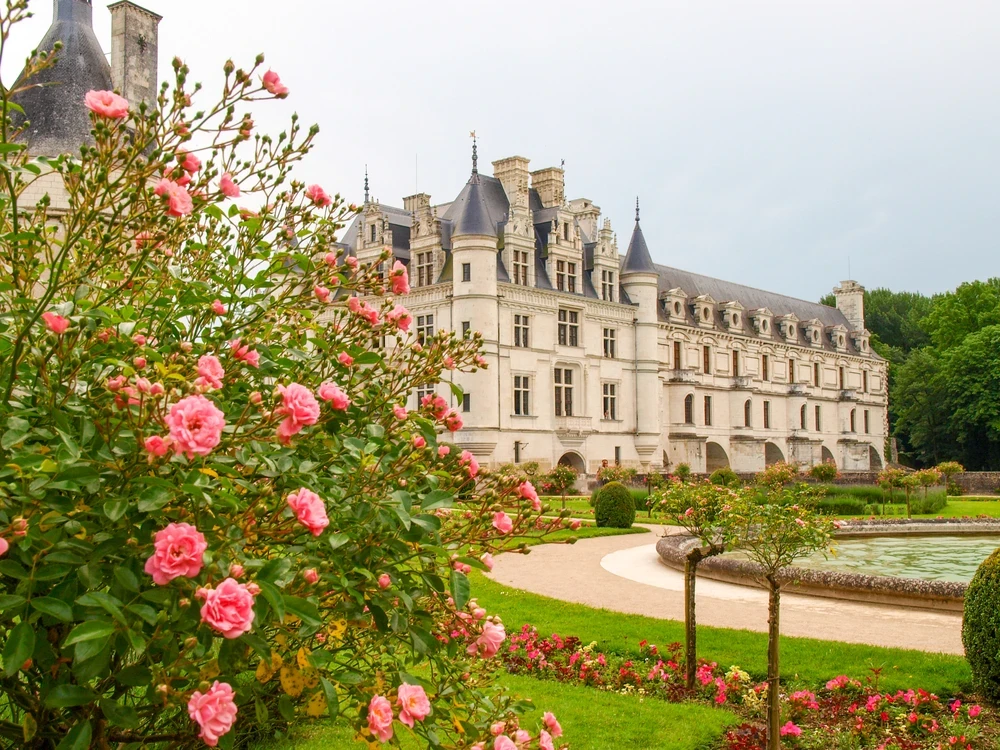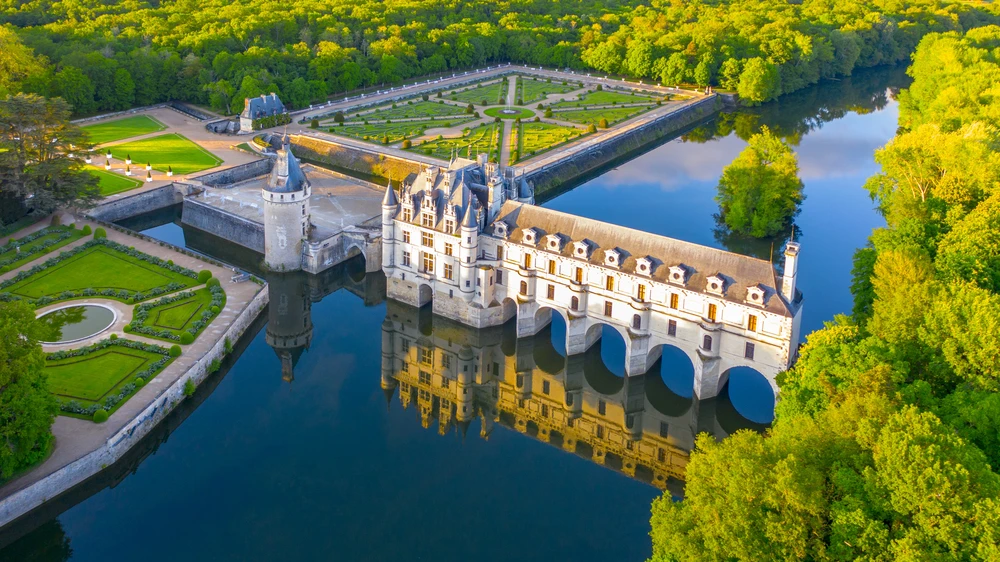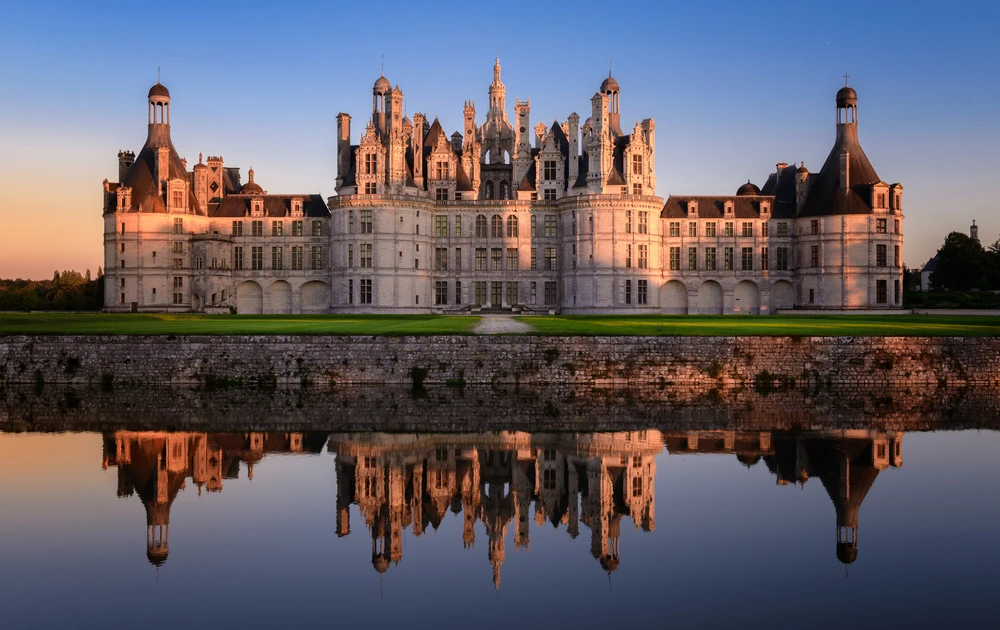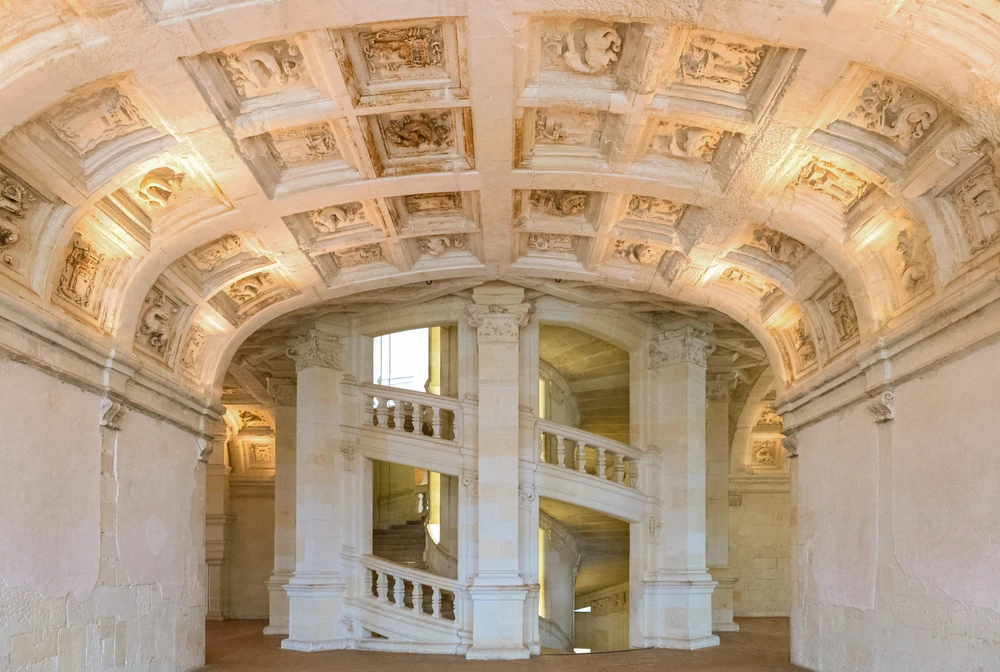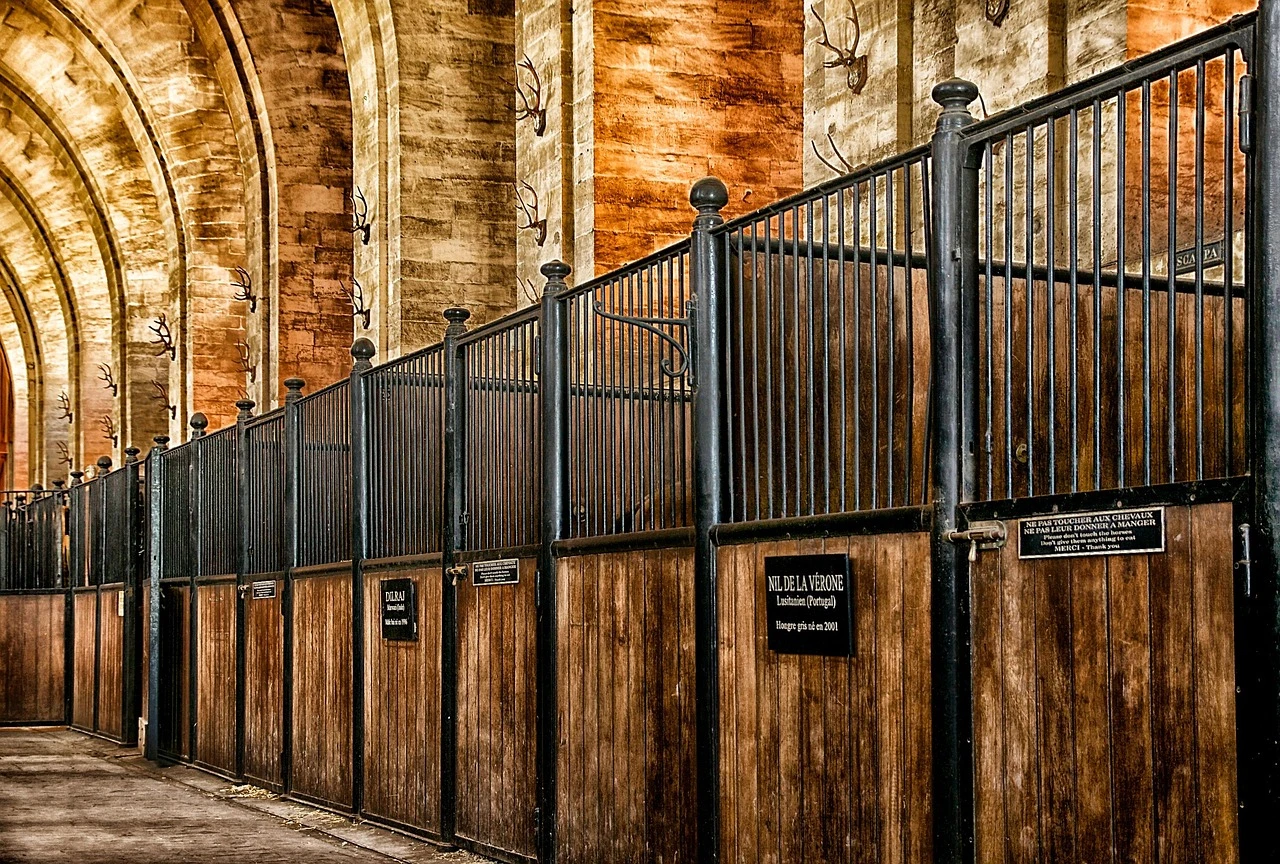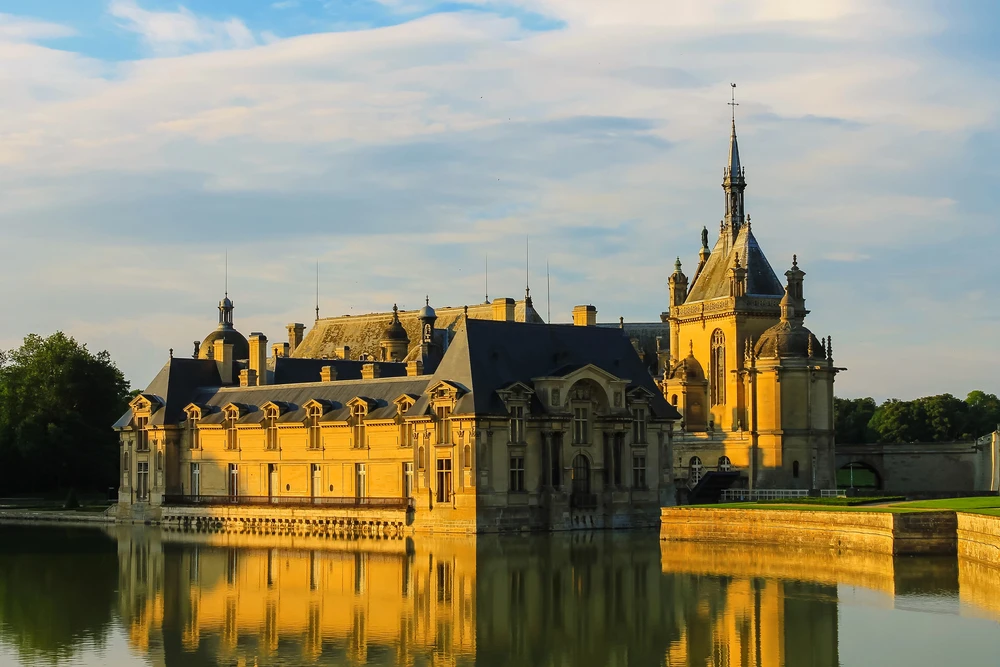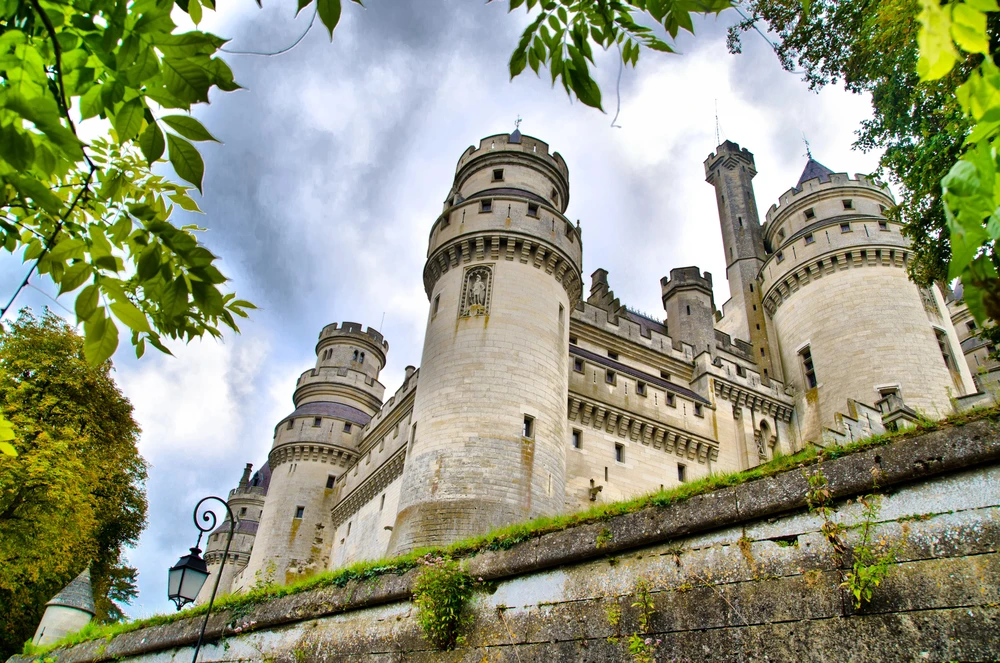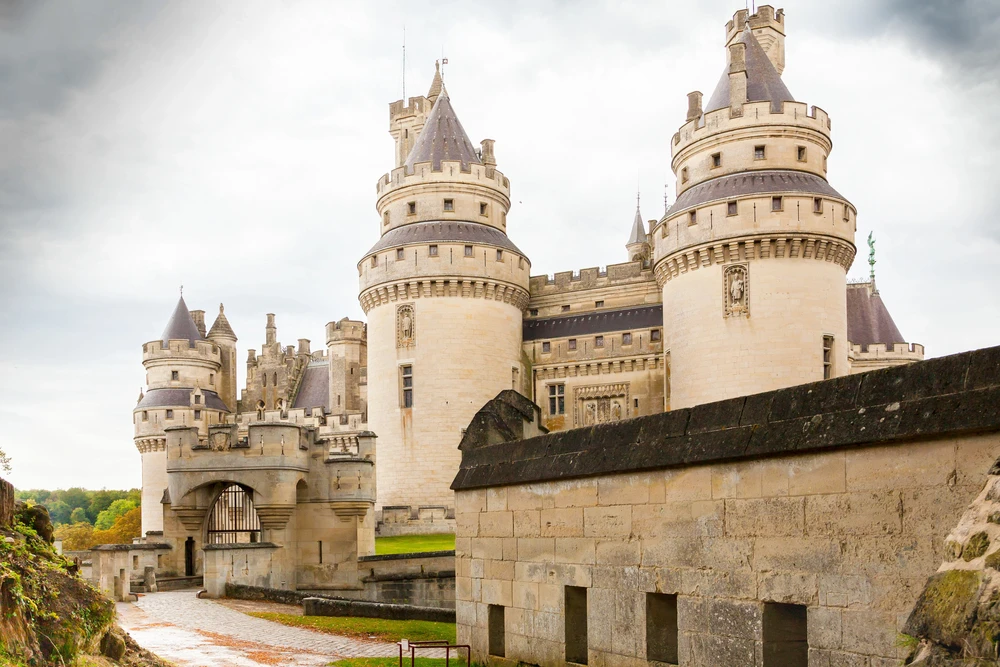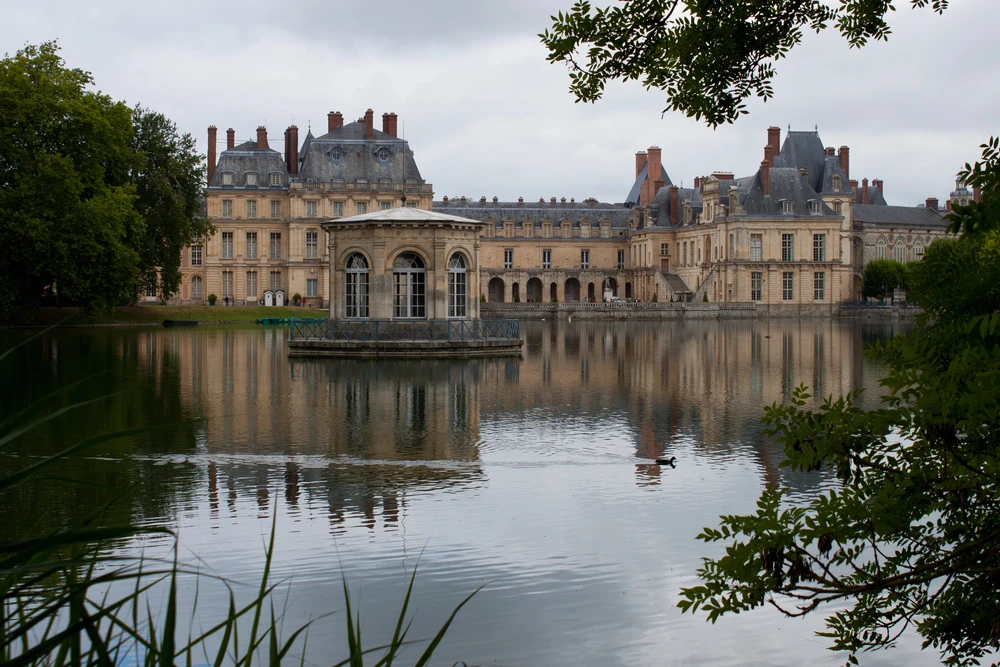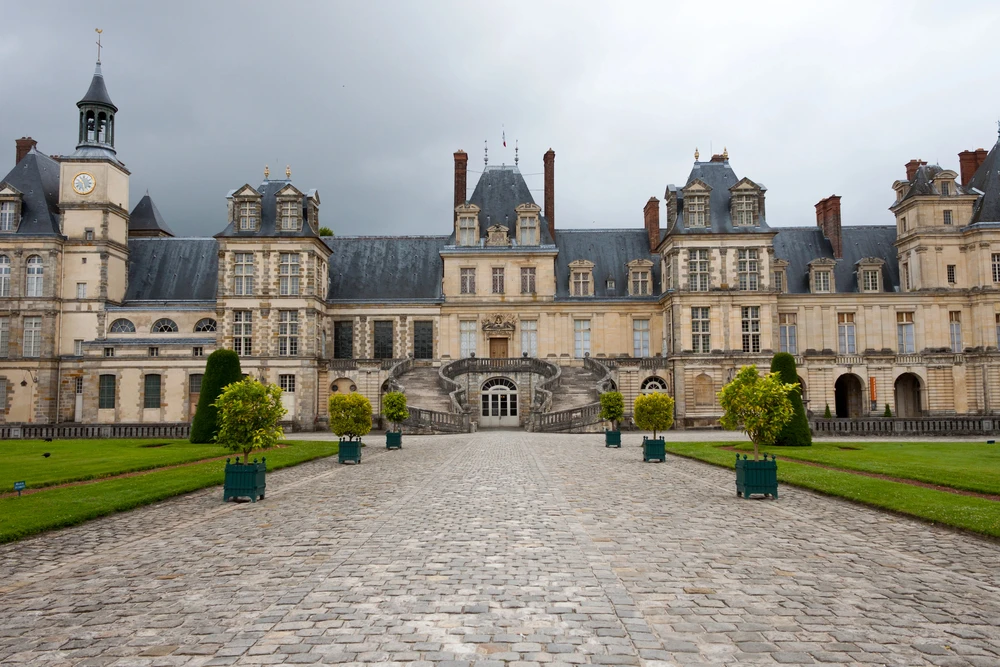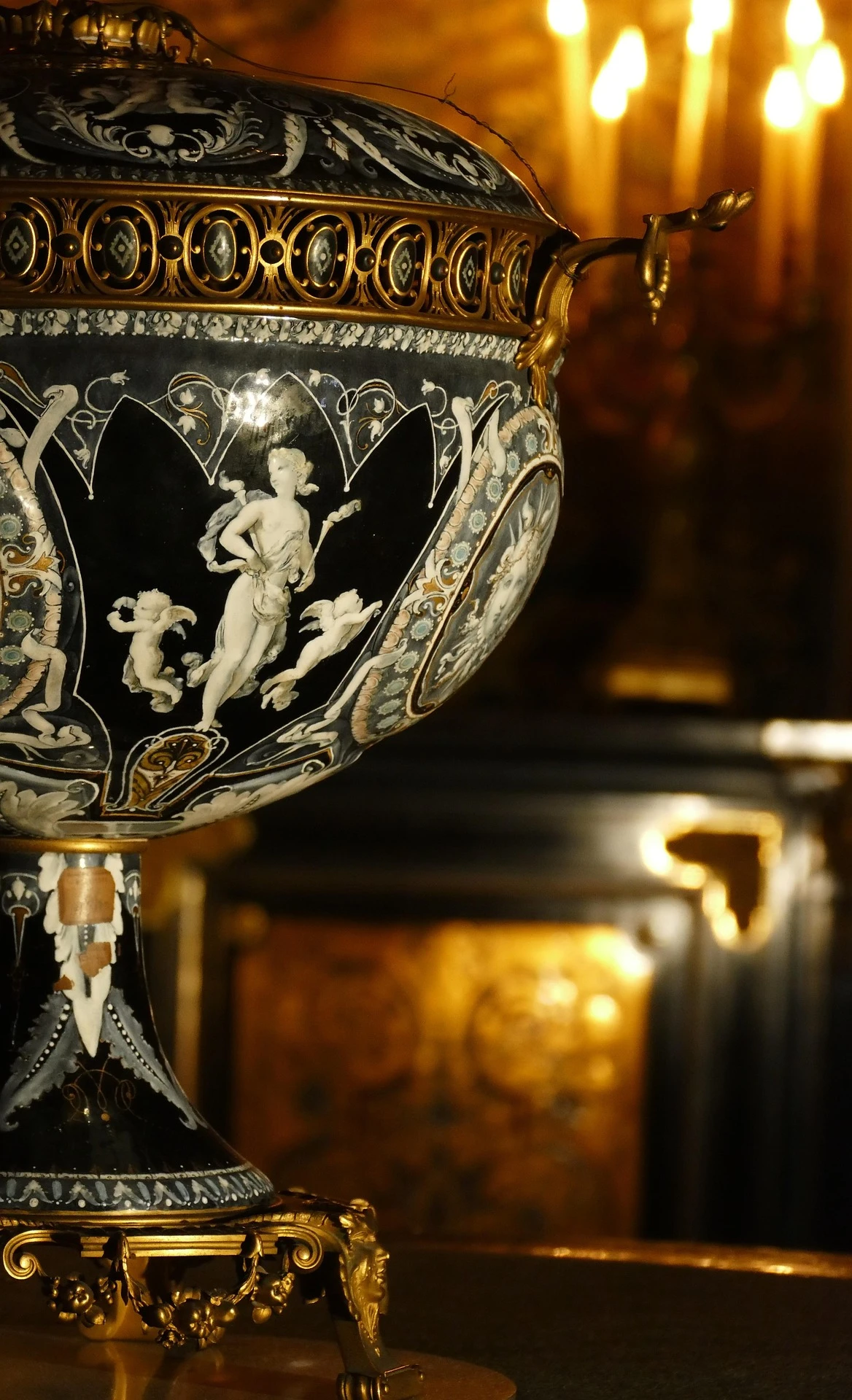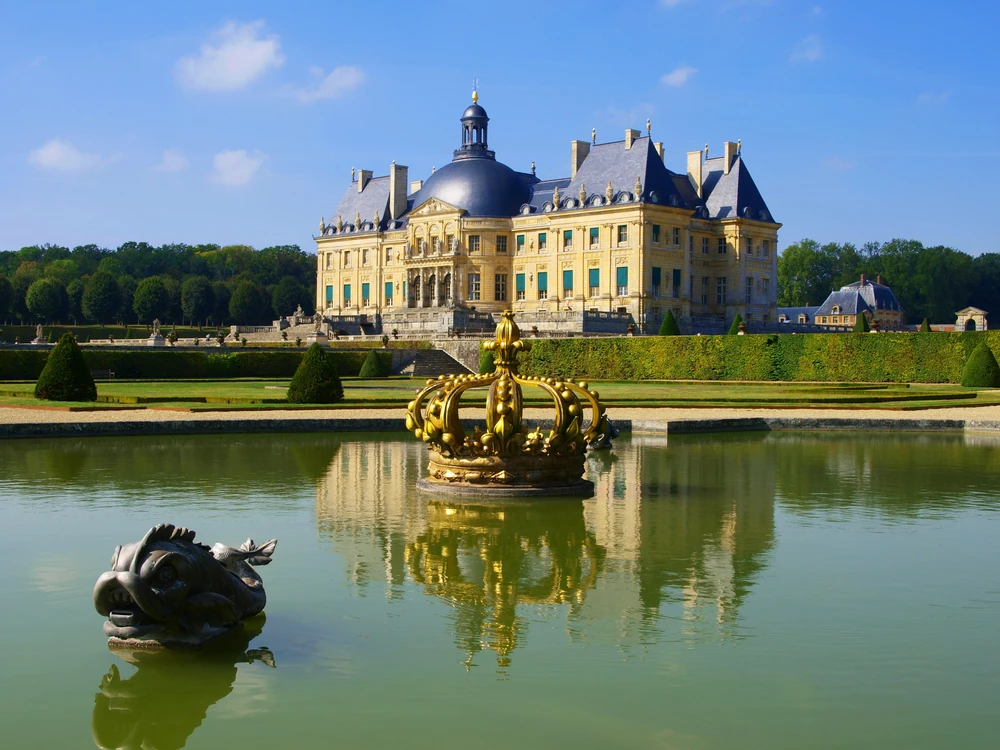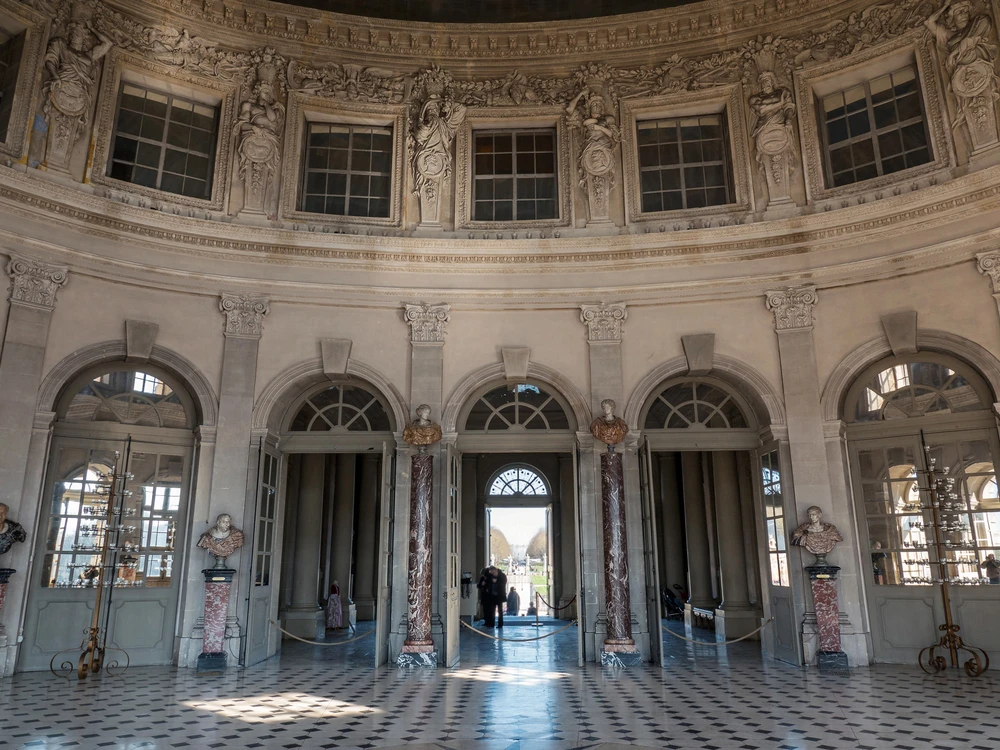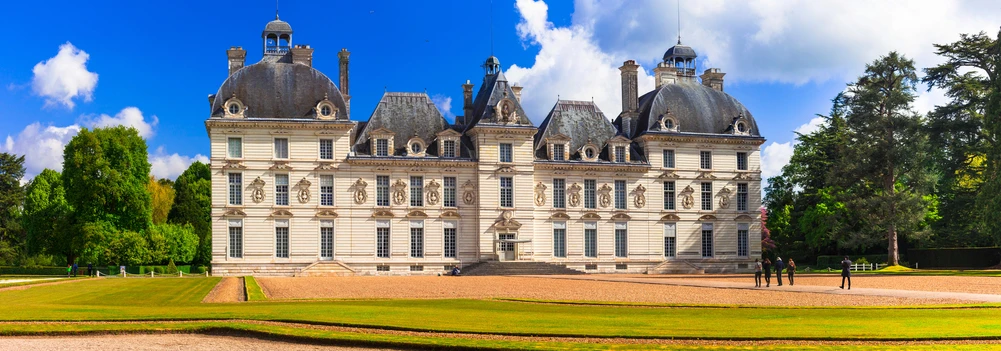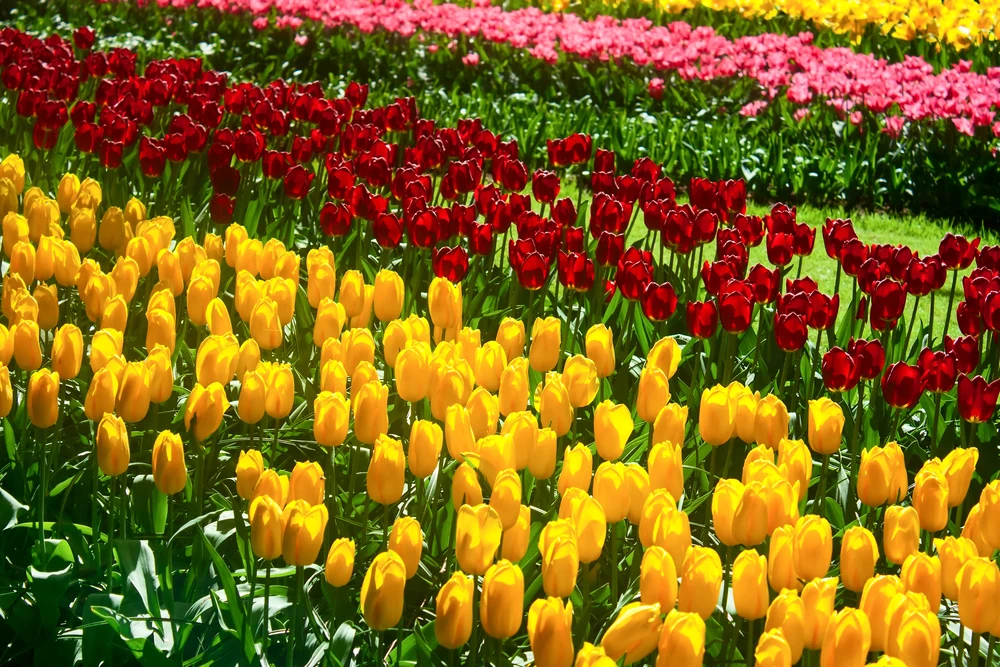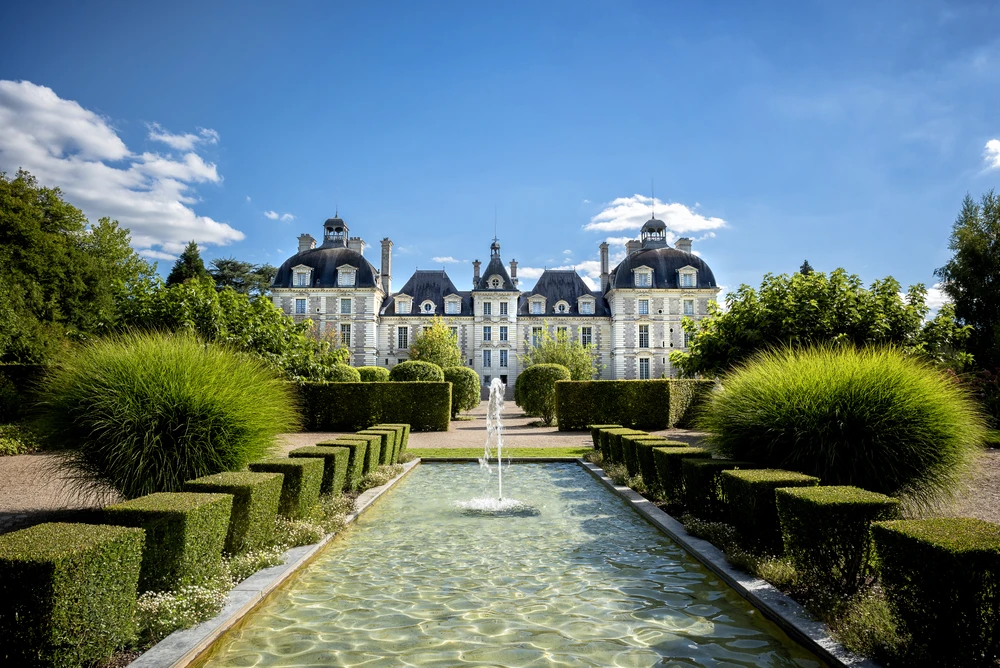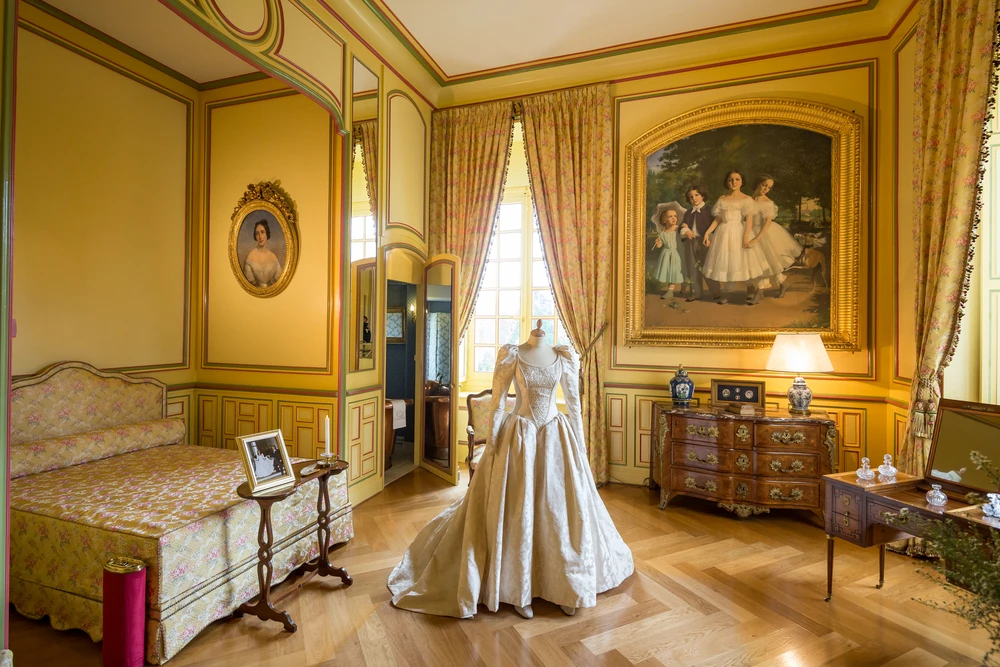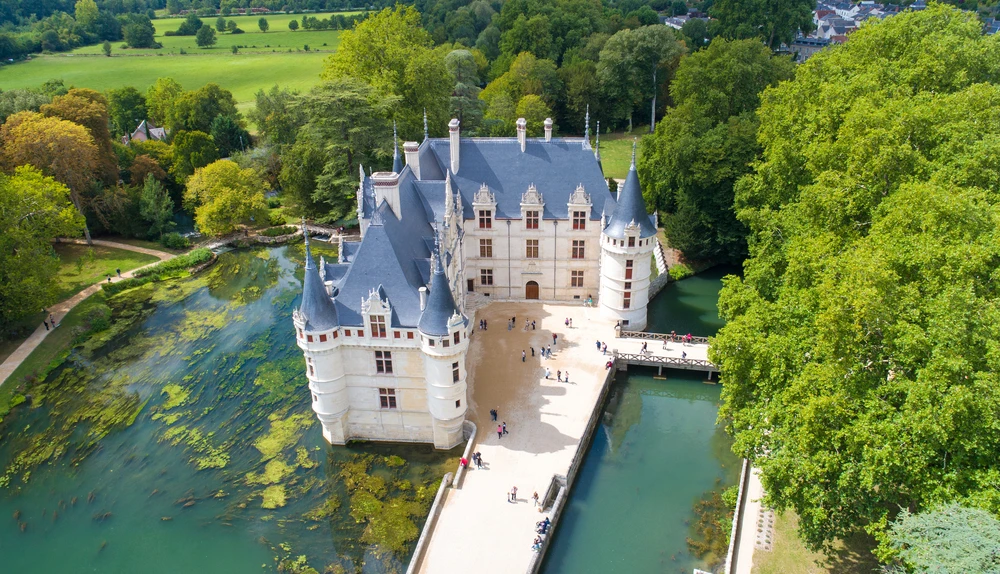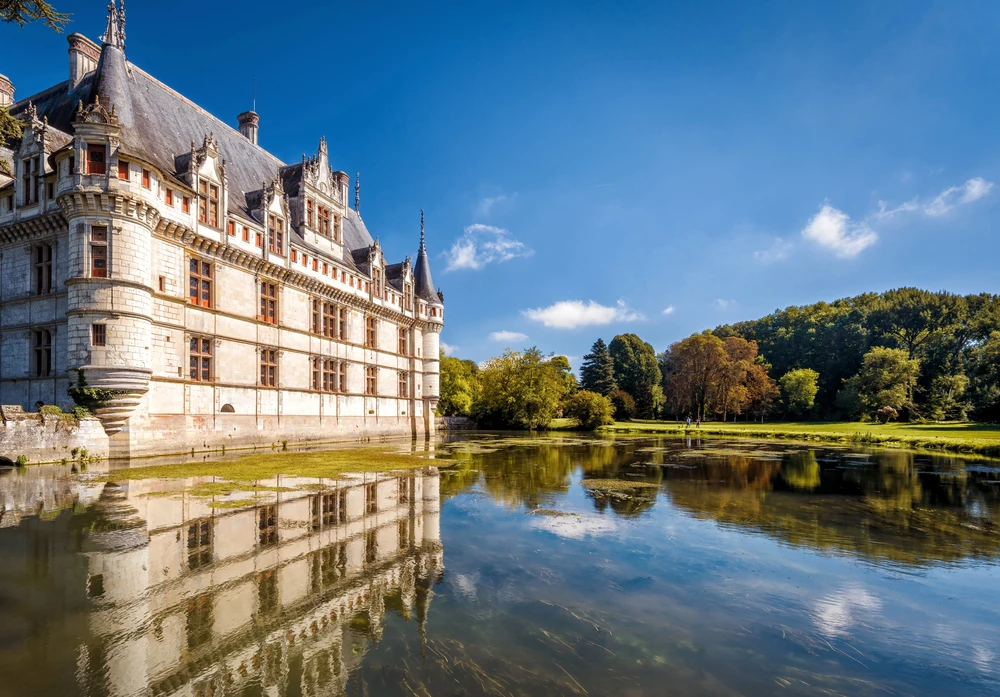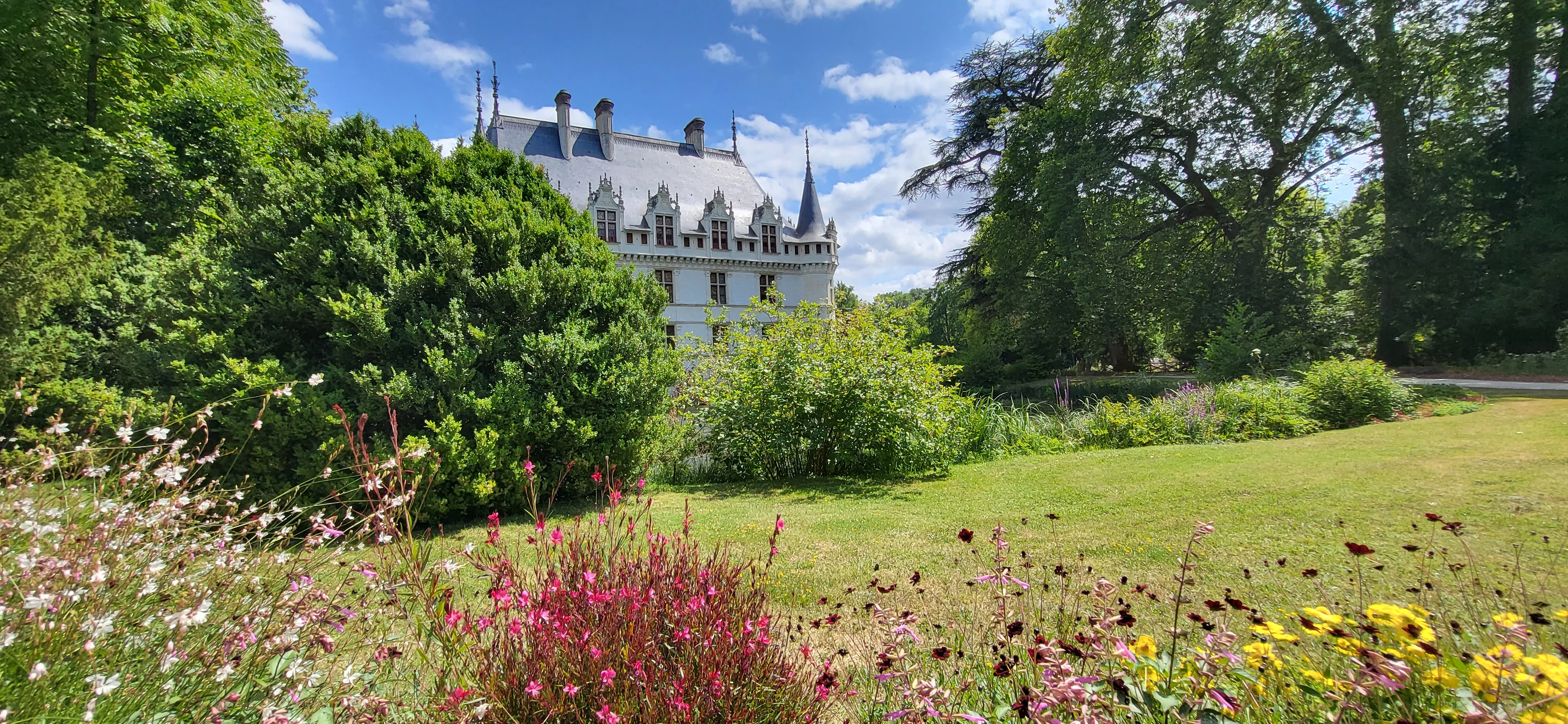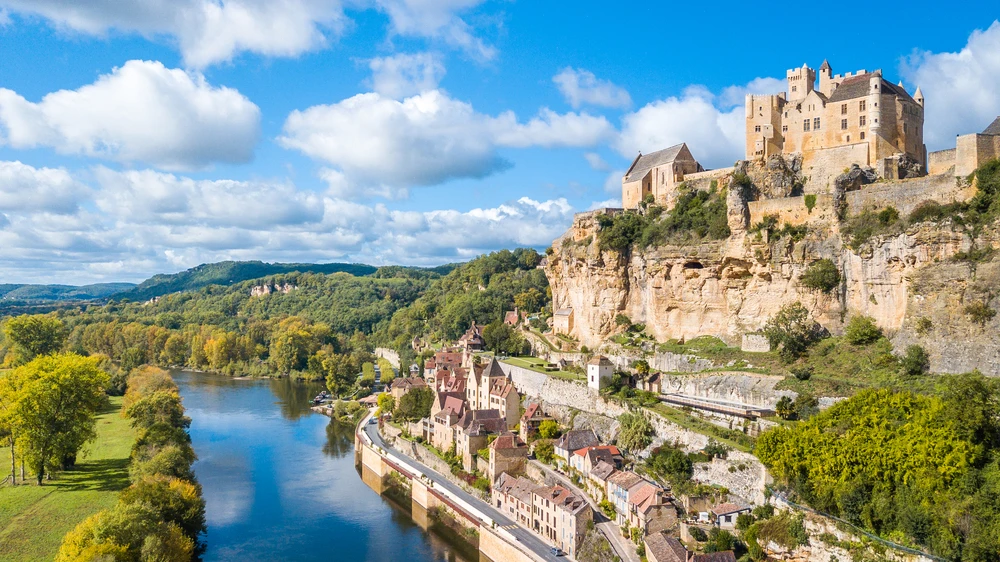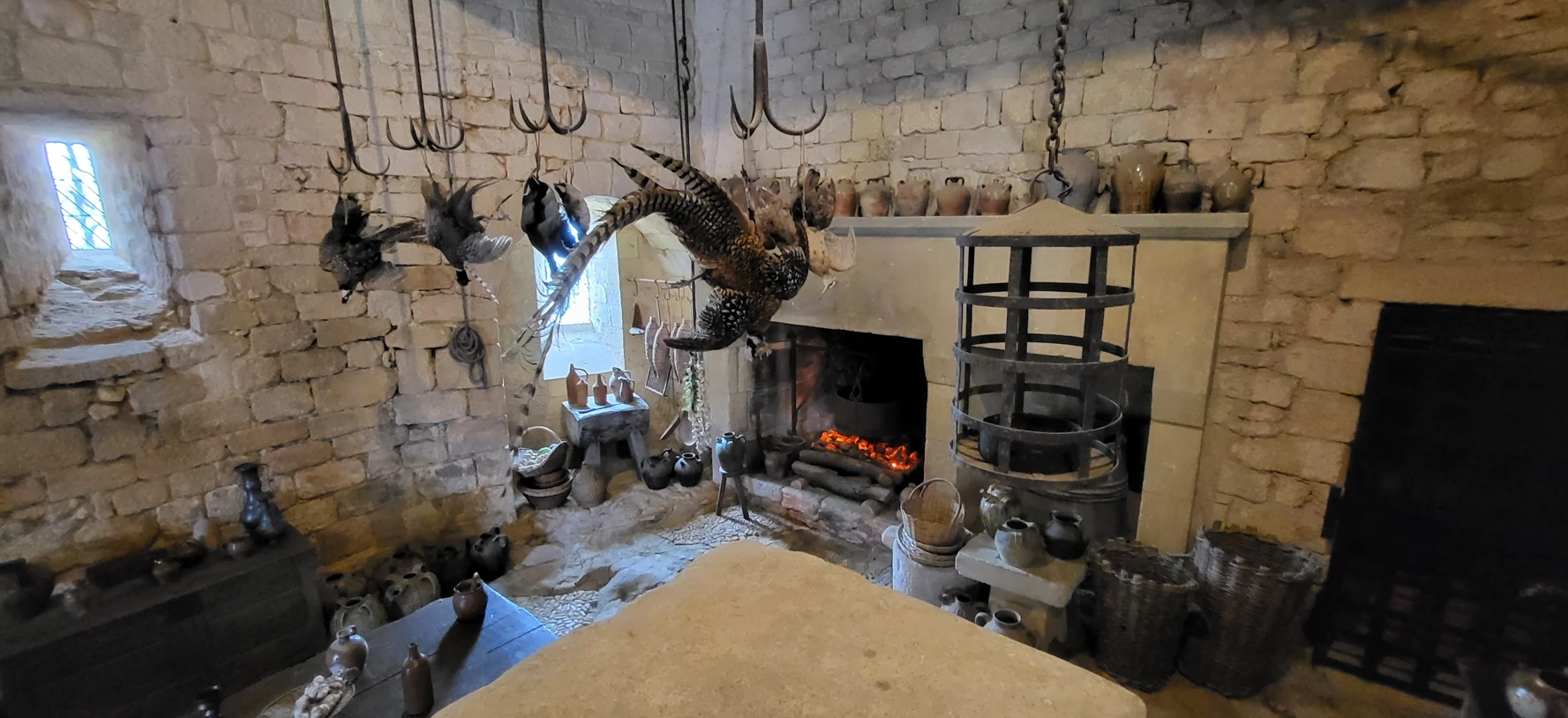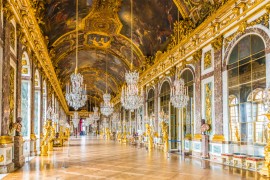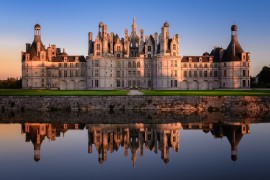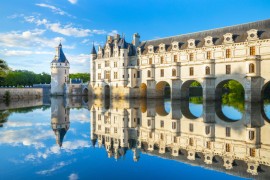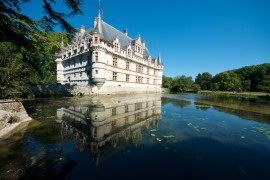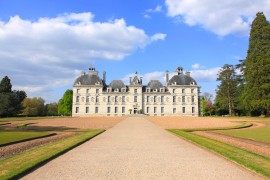1 The Palace of Versailles: the king of castles
The marble courtyard of the Château de Versailles / Photo chosen by monsieurdefrance.com: plmprod via depositphotos
Versailles, I hesitated to include it in this ranking of the 10 most beautiful French châteaux because more than a château it's a royal palace, but it's named a château and is therefore fit to enter this ranking with the royal crown because it's at once the most beautiful, the largest and the richest in history. Home to the kings of France, by the will of Louis XIV, from 1682 to 1789, it saw all the geniuses pass through for a century, whether in the arts or in literature and even in politics since it was here that France's destiny was decided. Most tourists concentrate on the palace itself, but it's a pity to go to the Château de Versailles without visiting Trianon and the Queen's hamlet.
The famous Hall of Mirrors, which owes its name to 357 mirrors / Photo chosen by monsieurdefrance.com: shutterstock.
Visit
Visit Versailles in spring when the French gardens are in full bloom, or in autumn when the park's trees turn gold and red. These are the two best seasons. To save time, if you're only there for a day, take out an annual subscription. You'll save time queuing and get a magazine that's always interesting. Finally if you can plan your visit well in advance, try a guided tour of the king's small apartments. It's delightful to see, and you'll get right into the French art of living.
Versailles in figures
The Château de Versailles seen from the park and the Appolon Basin/ Photo chosen by monsieurdefrance.com: plmprod via depositphotos
Versailles in figures is, for the château:63,000 M2, 583 meters long, including 73 meters for the Hall of Mirrors, which takes its name from the 357 mirrors it contains, which were a technological feat when it was built in the 17th century. As for the park,it covers 800 hectares, has200,000 trees and the parterres are 930,000 M2. There are also 200 statues, 55 fountains and over600 water jets.
Gilding with the sun, emblem of King Louis XIV.
2 Château de Chenonceau: the ladies' castle
The Château de Chenonceau is a magnificent bridge over the Cher. In fact, it was being a bridge that saved it from the French Revolution, which planned to destroy it. Photo chosen by monsieurdefrance.com: shutterstock.
It's the jewel in France's crown of private châteaux, and perhaps the most beautiful if Versailles is removed from the ranking of France's most beautiful châteaux. Chenonceau is the castle of the ladies because one of them had the castle built in 1513, her name was Catherine Briçonnet, the other had the bridge built over the river, Diane de Poitiers, and the 3rd had the great gallery built over the bridge, she was Queen Catherine de Médicis. We mustn't forget Queen Louise de Vaudémont, who lived here after the death of her husband King Henri III in the 16th century, Louise Dupin, who welcomed the intellectuals of her time, including Jean Jacques Rousseau, and Madame Pelouze, who restored its proud appearance;
Visit
The gardens at Chenonceau are superb / Photo chosen by monsieurdefrance.com: depositphotos
Don't overlook the gardens, including the magnificent parterre de Diane de Poitiers, the rose season is magnificent in May June and the park is over 30 hectares. It contains some treasures that tourists don't always go and see and that's a shame. Before going to the château,take the time to visit the "communs" with the vegetable garden(the plants are explained), the small vehicle museum too, which always appeals to children, as does thefarm animals.
Chenonceau in figures
The château welcomes more than 2,000,000 visitors a year. But the figure shouldn't frighten, even in the heart of summer when it's very busy, you can enjoy the château without a rush.
Magnificent château de Chenonceau / Photo chosen by monsieurdefrance.com: depositphotos
3 Château de Chambord: the genius and the king
Chambord is one of France's greatest châteaux. It was the brainchild of François 1er, and its staircase is probably the work of Leonardo da Vinci / Photo chosen by monsieurdefrance.com: shutterstock.
Chambord was the brainchild of King François 1er who wanted to build a modern château that would combine the best of Italian architecture with a French touch. It was built in 1519. Its double-revolution staircase, which means you can go up without passing those coming down but seeing them, is probably the brainchild of Leonardo da Vinci, who ended his life at the king's court not far away, in Amboise. Chambord was home not only to Louis XIV's court, but also to some amazing characters who lived there, such as the Marshal of Saxony, the Count of Saint Germain, a sort of magician, and the Count of Chambord, the last heir of the Bourbons to the Crown of France in a direct line.
Visit
Le château de Chambord et son jardin à la française / Photo chosen by monsieurdefrance.com: shutterstock
Everything is big at Chambord, just one side of the château is 152 meters long.Think, then, of prioritizing the comfort of your feet. In my opinion, it's in summer that the Château de Chambord is the most pleasant to visit, not least because it's cool inside.The visit is really worthwhile because you cross all the eras of French history, from the 16th century to the 19th. Chambord is quite magical in winter, when there's frost, or when the festive lights illuminate the château and make it shimmer. Last but not least, it's a great place to visit if you love hiking and heritage too, since its 5440-hectare park, nearly a third of which is natural space, is criss-crossed by 20 kms of marked hiking trails.
The double spiral staircase at Château de Chambord / Photo chosen by monsieurdefrance.com: shutterstock-1663463326-
Chambord by the numbers
Chambord is the castle of all records. It counts 440 rooms, 282 fireplaces and its park is enclosed by 32 kms of walls. The park's surface area is equivalent to that of the city of Paris. It is the largest enclosed park in Europe. With such volumes, there's no fear of being overwhelmed with people when you go there, there's plenty of room to accommodate the 700,000 annual visitors.
Superb Chambord at sunset / Photo chosen by monsieurdefrance.com: shutterstock
4 Château de Chantilly: the castle of princes
Le château de Chantilly / Photo chosen by monsieurdefrance.com: rimufilms via depositphotos
Chantilly is the home of the Princes de Condé, cousins with the King of France, who turned it into a sumptuous palace. Stunningly triangular in shape, it was donated by its last heir, the Duc d'Aumale, to the Institut de France, which manages its estate and collections, which are enormous, second only to those of the Louvre, such was the Duc's love of art (and wealth). Horses have their palace in Chantilly before the fantastic stables, which are a must-see. They can accommodate up to 240 horses and 500 dogs. A château considerably damaged during the French Revolution, which the duke almost entirely rebuilt in the 19th century to make a personal museum. Chantilly was also the home of the famous François Vatel, one of France's greatest chefs (he is said to have invented crème chantilly) and one of the first events professionals in history. A man who managed to impress Louis XIV with his creativity for parties and the table, so much so that the king wanted to bring him to Versailles. Tragically, he ended his life by committing suicide because his seafood order had not arrived and he thought the Court would not have a meal. The order arrived just minutes after his death...
Visit
If you're in Paris, there's nothing easier than coming by train. You're 25 minutes from the Gare du Nord station. Remember to take your time if you love art, because the collections are truly breathtaking. You can see paintings by Raphaël (the 3 Graces), Nicolas Poussin, Delacroix... But also sumptuous 18th-century furniture, porcelain collections... The works of art are arranged as they were in the 19th century, since the Duc d'Aumale made it a condition of his legacy that what he had installed should not be altered. Numerous equestrian shows are offered throughout the year;
Some of the 150 stalls at the Chantilly stables / Photo chosen by monsieurdefrance.com: Pixabay
Chantilly in figures
The library has 13,000 books.The Chantilly estate covers 7,800 hectares, only slightly less than Versailles. As at Versailles, we owe the French gardens to André Lenôtre (17th century), and there's a grand canal. The Musée Condé contains 800 paintings, 1,500 drawings, 1,500 manuscripts, 200 of which date back to medieval times, including the most beautiful medieval book in the world: the very rich hours of the Duc de Berry with its hand-drawn drawings.
Chantilly at sunset / Photo chosen by monsieurdefrance.com : Nicknick_ko via depositphotos
5 Château de Pierrefonds: the imaginary castle
Located in the Oise region of France, Le château de Pierrefonds is an architectural and historical masterpiece. Originally built in the 14th century by Duke Louis d'Orléans, brother of Charles VI, the château was dismantled in the early 17th century on the orders of Cardinal de Richelieu (like most of France's great fortified castles, to prevent the nobles from rebelling against the king). In the 19th century, the ruins were rediscovered by architect Eugène Viollet-le-Duc. He literally rebuilt the château for Emperor Napoleon III. We owe him the preservation and embellishment of Notre-Dame de Paris (the spire in particular) and the reconstruction of the Carcassonne fortress at the same time. It has to be said that the era was passionate about the Middle Ages and Eugène Viollet-le-duc was the best in the neo-Gothic style, a style that takes the architectural codes of the Middle Ages and exaggerates them. Cthis magnificent château is an interpretation of a medieval castle. A must-see: the enormous keep, the sumptuous interiors, and the village, which is well worth a visit.
The Château de Pierrefonds was almost entirely rebuilt and imagined by Viollet le Duc in the 19th century / Photo chosen by monsieurdefrance.com: gorielov via depositphotos
Visit
It takes 2H to visit the château. If you have the time, take the opportunity to discover the forest and château of Compiègnes which are right next door. From Paris, it's a 1-hour drive.
Pierrefonds in figures
The castle is 5000 M2, with 8 towers. The keep is 50 meters high. Restoration cost 5 million gold francs, a colossal sum at the time. It welcomes around 250,000 visitors a year.
Le château de Pierrefonds / Photo chosen by monsieurdefrance.com : markpittimages.gmail.com via depositphotos
6 The Château de Fontainebleau: the home of centuries and the true house of kings
The superb Château de Fontainebleau / Photo chosen by monsieurdefrance.com: bukki88 via depositphotos
It was Napoleon 1st who dubbed the Château de Fontainebleau "the house of centuries" It has to be said that the château has seen all those who have ruled France from the 16th to the 20th century pass through it, as General de Gaulle also happened to pass through. The kings of France, such as François 1er, to whom we owe the first château, Louis XIV, who stayed there in summer, and who even hesitated to make it his home rather than Versailles, Louis XV, who married there at the age of 15 and adored the château... But also emperors such as Napoléon 1er who considered it his home or Napoléon III who stayed there so often that he had the treasure that is the theater fitted out. Even a pope spent some time there in the 19th century. Fontainebleau encompasses every architectural style from the Middle Ages to the 19th century, including the Renaissance and the Grand siècle, since every king has built here. Fontainebleau is home to the famous horseshoe staircase, the Chapel of the Holy Trinity, Francis I's gallery, its 60-meter length and astonishing elephant, Napoleon I's inner apartments and one of the Emperor's only surviving thrones. Empress Eugénie de Montijo returned here in the 1910s, shortly before her death, initially anonymously, to revisit the places where she had lived and which she had had to leave 50 years earlier.
Visit
Please allow half a day to explore the château. The gardens are always open. The Fontainebleau forest is superb, just 60 kms from Paris. In fact, it's a favorite destination for Parisians to get some fresh air or take part in sporting activities such as hiking and climbing.
The famous horseshoe staircase at Fontainebleau / Photo chosen by monsieurdefrance.com / bukki88 via depositphotos.
The Château de Fontainebleau in figures
The forest of Fontainebleau covers 25,000 hectares. The château's grounds cover 130 hectares, including a French garden, an English garden and three ponds.The château itself contains over 1,500 rooms and almost 10,000 works of art, each one unique. It attracts 500,000 visitors a year. It is 70 kms from Paris (1H10) and accessible by train.
One of the 10,000 objects housed at the Château de Fontainebleau / Photo chosen by monsieurdefrance.com : Image by Eveline de Bruin de Pixabay
7 Château de Vaux le Vicomte France's most beautiful private château
Vaux le vicomte and one of the water beds / Photo chosen by monsieurdefrance.com: mari_five via depositphotos
This is France's most beautiful private château, along with Chenonceau. Without Vaux le Vicomte, there'd be no Versailles, since it was here that Louis XIV recruited those who would bring the world's most beautiful château to life. Vaux le Vicomte is indebted to Nicolas Fouquet (1615-1680), Louis XIV's superintendent of finance. The man was so successful in life that he built himself a magnificent château and invited the king, his boss, to please him. Except that Louis XIV, too dazzled, took it very badly and had Fouquet arrested a few months later (by d'Artagnan, incidentally). The château was designed by the three geniuses of the Grand Siècle: architect Louis Le Vau, painter Charles Le Brun and gardener André Le Nôtre. Begun in 1656, it was completed in 1661: 5 years of work alone is quite a feat. Vaux le Vicomte has belonged to several families and is nowthe estate of the de Vogüé Family, who have brought it into our era and made it a very high point of tourism in Ile de France (it's located in Seine-et-Marne). To see; the outbuildings, which are immense, the interior of the château, of course, with the famous Salle des Muses and the large oval salon offering a panoramic view of the gardens. The parterre covers 33 hectares, with water features. You have to go to Versailles to see such beauty;
L'interieur du château de Vaux le vicomte / Photo chosen by monsieurdefrance.com: pio3 via depositphotos
Visit
The château is close to Paris (62 Km, 1H23 drive). You'll need to spend at least half a day there. You can get there by train from Melun station and then take a cab, Uber or the château shuttle. Of course, it's beautiful all year round, but it's a magical moment to discover it at holiday time. The château is enchanting and the interiors are beautifully decorated. The château also offers nighttime candlelight tours that are extraordinary to experience.
The château de Vaux-le-Vicomte in figures.
The château is 1500 M2. It is surrounded by a moat and a 33-hectare designed parterre. it employs 75 people and attracts 500,000 visitors a year. If you're staying at Disneyland, don't miss Vaux le Vicomte, it's right next door.
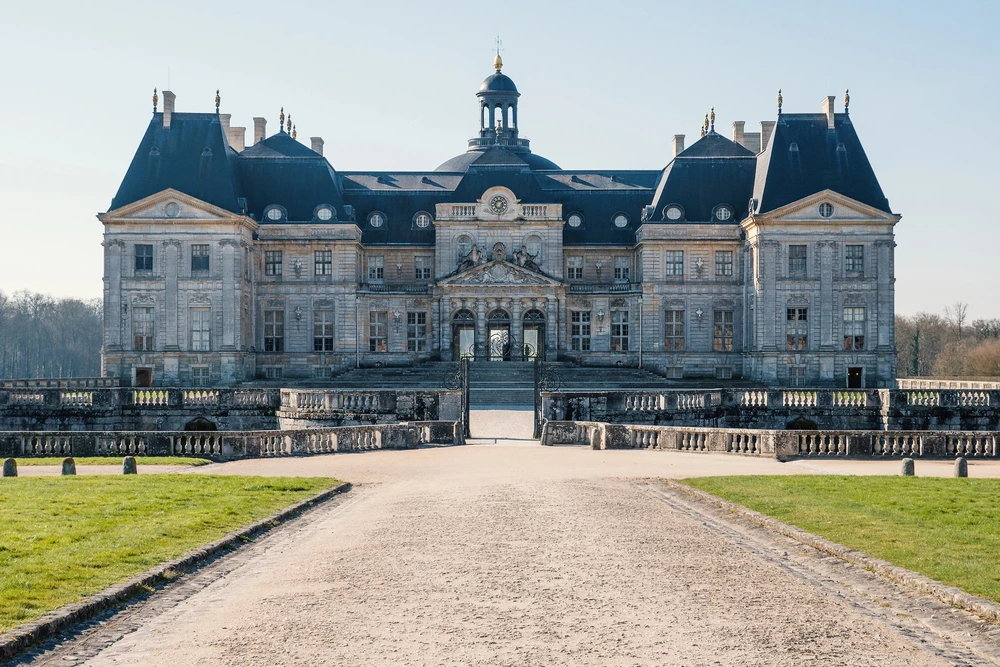
The entrance to the Château de Vaux le Vicomte / photo chosen by monsieurdefrance.com: pio3 via depositphotos
8 Château de Cheverny: the French château par excellence.
Le château de Cheverny / Photo chosen by monsieurdefrance.com: Maugli via depositphotos
I loved Cheverny. If you want to get an idea of what French château life might have been like, this is the château to choose. A beautiful, all-white château, typical of the 17th century. It was built in just 10 years, at the end of the reign of Louis XIII (1624-1634). It's a family home, and notably the residence of the Marquis de Vibraye since the 16th century.It inspired the Château de Moulinsart, featured in Tintin's adventures and a museum is dedicated to Tintin. The interiors are superb and, in addition to the halls of honor, we enter the intimacy of aristocratic families by discovering bedroomsand even children's rooms and toys. The castle is also very famous for its gardens and its incredible collection of tulips and other bulbs. Over 500,000 bulbs are planted each year, so you can imagine the spectacle in spring. The hunting pack is always there, and you can see the dogs. The hunting room is astonishing with its 2,000 trophies;
Cheverny is spectacular when the 500,000 bulbs bloom in spring / Photo chosen by monsieurdefrance.com: depositphotos
Visit
Take your time. You visit the château, of course, but you also need to take in the sights and not hesitate to observe the details (staging of the rooms, but also sculptures and woodwork).It's in April that the gardens are at their most spectacular since that's when the 500,000 tulips bloom, but they're also very beautiful all year round. There are works of modern art in the park, and the 6 landscaped gardens are fascinating if you love gardening or nature.
One of the facades of Château de Cheverny / Photo chosen by monsieurdefrance.com
The Château de Cheverny in figures
Château de Cheverny is the 2nd most visited private château in the Loire Valley, after Chenonceau. It welcomes almost 250,000 visitors a year. There are 6 gardens, each with its own special character;
L'interieur de Cheverny ou l'art de vivre à la Française / Photo chosen by monsieurdefrance.com: depositphotos.
9 Le château de Azay le rideau: the fairytale castle.
Le château d'Azay le rideau is an island / Photo chosen by monsieurdefrance.com: depositphotos
It's simple: this is the château we imagine as the setting for Cinderella. An all-white, Renaissance-style castle dating from 1517, positioned on an island in the middle of the River Indr. You can visit the interiors and admire how each inner stone is delicately carved. The gardens are an enchantment, especially in summer, as they are anEnglish-style park that encourages romanticism.
Le château de Azay le rideau / photo chosen by monsieurdefrance.com: scaliger via depositphotos
Visit
Go there in summer and treat yourself to a little drink right out front.The village of Azay le rideau is also worth a visit, it's packed with good eateries for gourmands.
Take time to admire the stone-cutting during your visit to the château de Azay le rideau / photo chosen by monsieurdefrance.com: Jérôme Prod'homme
The château of Azay le rideau in figures
The château is 50 metres square. There are 18 rooms to visit. It is located on an island in an 8-hectare park.
The gardens of Azay le rideau in summer / Photo chosen by monsieurdefrance.com: Jérôme Prod'homme
10 Château de Beynac: the soul of the Middle Ages
If there's one land to be visited by castle lovers it's the Périgord. If you like fortified castles, you'll discover some extraordinary ones. The Château de Beynac is breathtaking. It dominates the landscape and the Dordogne river that flows at its feet (and 152 meters below the towers). It looks as if it has survived intact to our time through 7 centuries. In fact, it has been extensively renovated, and even saved. It gives a good idea of life in medieval fortresses. Interior, period frescoes, monumental fireplaces and furnished rooms immerse visitors in medieval history.
The Château de Beynac in Beynac-et-cazenac. Photo chosen by monsieurdefrance.com: jon_chica via depositphotos.
Visit
It takes 1H30 to 2H for the tour. Take a guide it's much nicer than the audioguide. Please note that it is closed for one month in winter (often in January). If you want to make the most of the Périgord, it's a good idea to find your base near Beynac, as you'll be right next door to its magnificent neighbor Les Millandes, not far from Sarlat and right in the center of the Perigord Noir and its sumptuous landscape.
The kitchens at Château de Beynac / Photo chosen by monsieurdefrance.com: Jérôme Prod'homme
The Château de Beynac in figures
150 meters above sea level, average wall thickness of 2 meters and 15 rooms to visit. The château has been the setting for major films including Jeanne d'Arc, by Luc Besson, and "les visiteurs" by Jean Marie Poiré.

